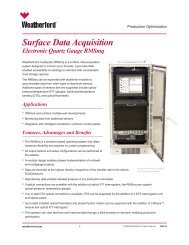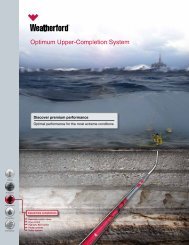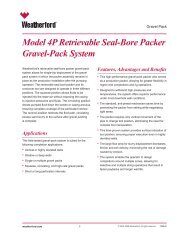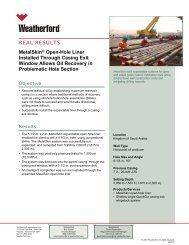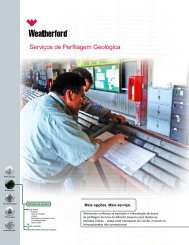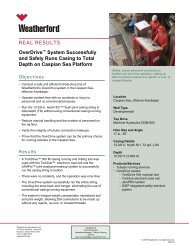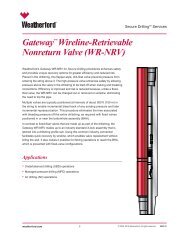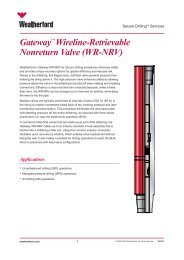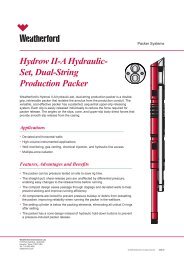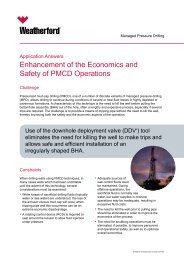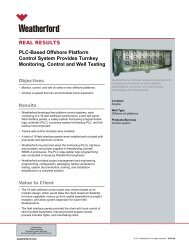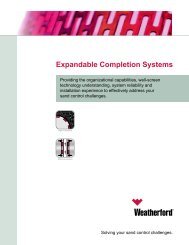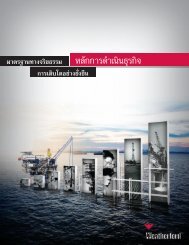Year-End Supplement - Weatherford International
Year-End Supplement - Weatherford International
Year-End Supplement - Weatherford International
- No tags were found...
Create successful ePaper yourself
Turn your PDF publications into a flip-book with our unique Google optimized e-Paper software.
Buildefficient formation evaluation.Compact tools deployedby coiled tubing successfullyacquired data in memorymode in a difficult to access,horizontal, underbalancedexploration well. This wasa case where conventionalwireline operations werenot feasible and pipeconveyedlogging poseda safety hazard.Efficient reservoir evaluation means access to the high-quality data youneed without compromising your operational and budgetary objectives.That’s why <strong>Weatherford</strong> developed the Compact suite of tools andservices. In addition to being ideal for all logging operations, including remoteland and offshore, the system’s compact size and versatility of conveyancehelps reduce rig personnel, equipment requirements and operating costs.And it does so while acquiring a wide range of measurements, regardless ofwell condition or geometry. More options. More service. That’s <strong>Weatherford</strong>.Visit weatherford.comThe Compact suite offers a widevariety of resistivity, porosity andlithology, natural gamma ray,acoustic, imaging and formationpressure measurements – regardlessof hole condition or well geometry.Image data contained in a horizontal coalbed methane wellwith Compact microimager on well shuttle.© 2008 <strong>Weatherford</strong> <strong>International</strong> Ltd. All rights reserved. Incorporates proprietary and patented <strong>Weatherford</strong> technology.
magazineA Fortitude for RiskStuart Ferguson, Senior Vice President,Reservoir & Production, and Chief Technology OfficerEditor-in-ChiefChristine McGeeVice President, Marketing ServicesManaging EditorChristine MathersManager, Corporate CommunicationsBusiness EditorsGary Aaron, Marketing ManagerAngie Gunden, Marketing ManagerShannon Myers, Marketing ManagerJudy Feder, Senior Marketing ManagerSherri Scott, Senior Marketing ManagerGraham Makin, Director, Technical MarketingMary Powledge, Technical EditorLayout and DesignEleanor Shanks, Senior Graphic DesignerProductionAnthony Drago, Production ManagerJan Stafford, Art DirectorA publication of<strong>Weatherford</strong> <strong>International</strong> Ltd.Vol. 10, No. 4<strong>Weatherford</strong>’s W Magazine is published by<strong>Weatherford</strong> <strong>International</strong> Ltd. Please direct allcorrespondence regarding this publication, includingreprint requests, toTina Graham, 713.297.2588 ortina.graham@weatherford.com.The sudden and severe economic downturn we have experiencedrecently is likely to encourage risk-averse tendencies. Now, however, isnot the time to retreat away from technology. The economy will recoverin time; there is no recovery from accelerating production decline ratesinherent in an aging oilfield. More than ever, we need technologies thatdrive down well costs such that we can develop marginal fields with robust economics.We also need to remain focused on well productivity and recovery factors, so that we canmaximize the value created from oilfield developments. All this being said, and recognizingthe challenge of additional perceived risk, we must do all we can to ensure flawlesstechnology adoption. Creating opportunity from adversity, I am confident that a stronger,better oil industry will emerge from this recession.This year-end supplement of W Magazine presents some of our more recent technicalabstracts that align our technologies with key client drivers. You may notice that this issueis organized a bit differently than our standard publication. Each article will cover one offour primary technology imperatives, as follows:Optimizing Well Costs: Drilling Efficiency. Modern wellbore construction requirescomplex planning and execution of sophisticated designs and the application of a diverserange of equipment and knowledge to effectively reach reservoir objectives. This articlehighlights projects from Indonesia to the North Sea, using a range of technologies—fromspecialized methods of underbalanced drilling and advanced technologies for wellconstruction to rig mechanization systems.Good to the Last Drop: Reservoir Recovery. Optimal controls and techniques must beapplied to understand an asset throughout the life cycle of the well. This article focuses onhow to extract the last hydrocarbon out of mature assets or maximizing recovery from anew reservoir through a deep technology portfolio.Keeping All the Options Open: Well Architecture. Maximizing reservoir contactand optimizing costs means having the flexibility to address all the challenges. Keytechnologies covered in this article include electromagnetic LWD for new telemetry inUBD wells, expandable tubulars for monodiameter wells and expandable completions formultizone compliance.Maximizing Value Takes All Types: Well Productivity. Addressing a range ofchallenges—from horizontal wellbores and complex well geometries to difficult reservoirsand those with marginal economics—requires exceptional tools and skills to go with them.This article illustrates <strong>Weatherford</strong>’s leading-edge efforts to ensure well-placed wells withzero formation damage.These summaries emphasize just a few of the ways <strong>Weatherford</strong> is helping operatorsachieve ultimate reservoir objectives.We hope you find this issue thought provoking about the kinds of technologies <strong>Weatherford</strong>has to offer and how those technologies can support your operational needs.forewordLooking ahead, the March issue of W Magazine will focus on how <strong>Weatherford</strong>is addressing the need for better drilling efficiencies. We will examine some ofthe technologies that help us all drill faster and mitigate hazards to deliver morecost certainty.’08 year-end supplement 1
Optimizing Well CostsdrillingefficiencyTo reach reservoir objectives on target and on budget, modern wellbore construction requires complex planningand execution of sophisticated designs, and the application of a diverse range of equipment and knowledge.The challenges presented by mature, often-depleted fields, unconventional assets and extreme reservoirenvironments are considerable. Achieving fast, efficient, problem-free drilling operations frequently depends onmatching technology to the application.<strong>Weatherford</strong> weaves a broad scope of technologies together to provide the most appropriate drilling solution.The diversity of this effort—along with the range of capabilities and knowledge being applied—is illustrated in thefollowing summaries.This article has captured the highlights of a few recently presented <strong>Weatherford</strong> technical papers that featureoperations from Indonesia to the North Sea. They discuss subjects as varied as specialized methods ofunderbalanced drilling and advanced technologies for well construction—from top-drive makeup systems to thepipe itself.These summaries emphasize just a few of the ways <strong>Weatherford</strong> is helping operators achieve ultimatereservoir objectives.Mitigating Drilling Hazards Using Cost Effective,Solid Expandable Monobore SystemsSource: MOC 2008David Stephenson, Pat York and Lev Ring, <strong>Weatherford</strong> <strong>International</strong> Ltd.Mitigating Risks with Solid-ExpandableMonobore SystemsWhile reduction of wellbore diameter during wellconstruction can be achieved using conventional solidexpandableopenhole liners, these systems typicallyresult in nonstandard internal diameters and significantdeviation from the planned well design. The result isoften an increase in well construction costs and elevatedoperational risk. Mitigating these limitations requires asimple, cost-effective means of extending casing shoeswhile maintaining the same internal wellbore passthroughdiameter.Working with operators in a collaborative effort to addressthis need, <strong>Weatherford</strong> has developed a high-collapse,cost-effective monobore expandable system focused ontwo key challenges—drilling through troublesome zonesand premature slimming of wellbore profiles.Monobore systems provide many advantages. As acontingency, they are a means to mitigate risks presentedby geologic uncertainty. In well design, they provideadditional casing strings.Monobore systems also facilitate other proactive wellconstruction techniques to improve well productivity andprovide access to previously nonaccessible reserves.And as the total depth of wells continues to increase,monobore systems will become a valuable resource toreduce well construction costs and significantly increasethe chances of successfully reaching objectives with ahole size conducive to forward operations.The utility of the system is illustrated by various linermethodologies used under the 13 5/8-inch casing, acritical string in most well designs. For example, theexpandable string is used to mitigate drilling hazards, toget a jump on pore pressure/fracture gradient challenges(either immediately under the 13 5/8-inch string or furtherdown the well), and provide cost savings by standardizingthe well design throughout a field.In salt formations, where solid-expandable liners havecontributed significantly to successful drilling operations,the advent of the 11 3/4- × 13 5/8-inch monoboreliner is a significant advancement of the technology.In particular, the monobore liner affords zero hole loss2 magazine
ConventionalOpenhole LinerConventional ExpandableOpenhole LinerD 0D 1D 1Monobore ExpandableOpenhole LinerD 0D 0D 113 5/8-in.casing andoversized shoedrillingefficiency11 3/4- or11 7/8‐in.casing11 7/8- x 13 5/8‐in.Expandable linerMonoboreexpandablelinerD 1< D 0D 1< D 0D 1= D 0Significant loss of hole size.Some loss of hole size.Zero loss of hole size.Well designs using conventional liners are constrained by tapering that reduces hole diameter with depth. Conventional expandables significantly reducetaper. But monobore liners augment expandable technology that eliminates downhole tapering.after installation, with more than twice the collapsestrength of conventional expandable liners. These linershelp facilitate successful and cost-effective drilling into,through and beneath salt formations.Proactive well construction techniques are beingconceived by drilling engineers globally. Although the13 3/8-inch/13 5/8-inch monobore openhole linerextensions may be considered as a planned contingency,its real value is realized when incorporated in the well’sdesign and after a proper evaluation of its potentialsavings is conducted.The 13 5/8-inch monobore openhole liner systemprovides an additional casing string that mitigates thepremature slimming of wellbore profiles. This systemprovides a contingency liner option while drilling throughsalt inclusions, enhancing the likelihood of reaching thebase of the salt with the planned hole size. Also, the13 5/8-inch monobore openhole liner helps managerisks related to geologic uncertainty associated withsubsalt exits. This liner provides pressure protection forthe 13 5/8-inch shoe while drilling through troublesomezones in the deepwater of the Gulf of Mexico. Its useadds an additional casing string to the design for a totalof six possible strings below the 13 3/8-inch casing withan option to add yet another string at total depth (TD).This synopsis is derived from MOC 2008, Mitigating Drilling Hazards Using Cost Effective, Solid Expandable MonoboreSystems, authored by David Stephenson, Pat York and Lev Ring, <strong>Weatherford</strong> <strong>International</strong> Ltd. The referenced<strong>Weatherford</strong> technology includes solid-expandable monobore systems.’08 year-end supplement 3
drillingefficiencyManaged-Pressure Drilling and Downhole IsolationTechnologies Deliver High Rate Gas WellsSource: SPE/IADC 114703Nyoman Dharma, ConocoPhillips, and J.S.S. Toralde, <strong>Weatherford</strong> <strong>International</strong> Ltd.MPD for High-Rate GasPressurized mud-cap drilling (PMCD), a variant ofmanaged pressure drilling (MPD), enables drilling tocontinue despite a total loss of circulation. This processis achieved while at the same time monitoring andcontrolling the entry of influx into the wellbore.A weakness of this technique is that the well still has tobe killed before pulling out of the hole, which can be timeconsuming and ultimately lead to formation damage.Using a downhole isolation system to eliminatekilling the well during and after PMCD operationswould, therefore, greatly improve the efficiency andeffectiveness of this drilling technique and enhance itsacceptability in operations where well productivity is amajor consideration.Recently MPD and downhole isolation technologies werecombined to provide this capability. Tests of the subjectwell, drilled in a highly prolific fractured gas reservoir inIndonesia‘s Suban field, show production rate potentialin excess of 300 million standard cubic feet per day.MPD with downhole isolation enabled drilling to continueeven with total loss of circulation, increased the safetymargin of operations, reduced the amount required ofmud and lost circulation materials (LCM), minimizedformation damage, and made running and installation ofthe completion assembly possible without the need to killthe well.The combination of the technologies opens the doorto construction of gas wells designed for increasedproductivity and output by deliberately seeking out largefractures while minimizing formation damage. As a result,fewer, but more productive wells, can be drilled to greatlyimprove the economics of gas field development.In the Suban field, wells with extensive reservoirfracturing dominated early production. Productionpotential was considered excellent with tests indicatingthat the fracturing system was well connected andthat large areas of the reservoir could be drained fromcentral locations.The PMCD variant of MPD was chosen because ittakes advantage of the natural capability of fracturedformations to swallow drilling fluids and the drillingcuttings. Rather than attempt to cure the circulationlosses, PMCD uses a viscous mud cap in the annulusto hold the reservoir pressure in balance, whilesimultaneouslypumping sacrificialdrilling fluid downthe drillstring. Thereare no returns to thesurface because thesacrificial fluid and allcuttings are lost tothe formation. Drillingcan continue despitesevere or total lossof circulation, andfluid costs are greatlyminimized.UBD and MPD haveestablished a commercialtrack record, onshoreand offshore, of providingsignificant measurablebenefits to drillingprograms by reducingor eliminating a litany ofdrilling-related risks.To avoid the costly process of killing the well beforepulling out of the hole at TD, the project deployed<strong>Weatherford</strong>’s DDV ® downhole deployment valvefor downhole isolation. Installed in the casing string,the full-bore, flapper-type valve eliminates the needfor snubbing operations or killing the well duringunderbalanced and near-balanced operations. Acommon installation, this application was unique inThis synopsis is derived from SPE/IADC 114703, Managed-Pressure Drilling and Downhole Isolation TechnologiesDeliver High Rate Gas Wells, authored by Nyoman Dharma, ConocoPhillips, and J.S.S. Toralde, <strong>Weatherford</strong><strong>International</strong> Ltd. The referenced <strong>Weatherford</strong> technology involves MPD systems.4 magazine
the use of a large 9 5/8-inch DDV tool installed in aretrievable mode, instead of being cemented in place.In drilling the well, operations were changed to PMCDwhen a major fracture was encountered. The DDV valvewas used during operations for the entire 600-foot(183-meter), 8 1/2-inch hole section. After retrieval, theDDV tool was found to be in good working order andready for service.drillingefficiencyThe PMCD variant of MPD with different fluid systems and equipment took advantage of the natural capability of fractured formations to accept drillingfluids and the drilling cuttings. There are no returns to the surface because the sacrificial fluid and all cuttings are lost to the formation. Drilling can continuedespite severe or total loss of circulation, and fluid costs are greatly minimized.’08 year-end supplement 5
Offshore Underbalanced Drilling—The Challenge at SurfacedrillingefficiencySource: IADC/SPE 112779Geoff Gough, <strong>Weatherford</strong> <strong>International</strong> Ltd., and Robert Graham, DONG EnergyUnderbalanced Surface ChallengesAn ambitious North Sea campaign using underbalanceddrilling (UBD) technology provided an excellentopportunity to examine the technologies’ surfaceoperation processes and challenges.Drilling in the Danish sector required careful managementof uncertain pore pressure conditions. In applying UBDtechnology, two key factors were at play—enablingthe drilling of the lower formation without casing off theupper, and proving UBD as an enabling technology forunlocking unrecoverable reserves in the area.Data showed that killing the well in the field a single timecould result in a 60 percent decrease in productivity,which highlighted a potential reserves upside tosuccessful use of underbalanced drilling technology. Inassessing this potential, surface handling equipment ona jackup rig was carefully examined during the drilling oftwo new wells.The wells were comprised of 6-inch horizontal sectionsthat were approximately 6,560 feet (2,000 meters)in length. UBD technology was selected to combatchallenges presented to conventional drilling byvariations in the pressure profile along these lengthyhorizontal sections.The anticipated inflow parameters demanded a thoroughexamination of the surface handling equipment, whichwas required to de-energize and separate up to 25,000barrels per day of returned/produced oil, water andcuttings, along with up to 30 million standard cubicfeet per day of gas. The system returned water to therig for the circulation system, disposed of cuttings inthe annulus of an existing well and routed producedhydrocarbons to the production platform. The firstwell also uses platform gas for annular gas injection tomaintain the required circulating pressure profile.A rigorous process design procedure was followedto determine the optimal surface equipment. Theequipment configuration required handling thecombination of drilling fluids, solids and well effluentthat came to surface, as well as evaluating potential forhydrate formation, foam and emulsions. Proceduresalso had to be aligned with rig, production platform andmultiple service company operations.In addition, a strategy was employed to facilitaterecovery of oil and gas produced duringunderbalanced drilling operations to the platformprocess facilities. Challenges included large volumesof friction reducers in the circulating system, lowerthan expected surface temperatures, ultrafine cuttingsand integration of the platform’s data acquisition andemergency shutdown systems.The project met all primary surface objectives.A progressive learning curve was demonstratedthroughout the project and an excellent safetyculture yielded top performance in health, safety andenvironmental protection. The campaign demonstratedthat underbalanced drilling is a viable technology forunlocking the field’s remaining reserves.A four-phase separation capability was among several key components ofthe UBD surface system used for the North Sea well. Other componentsincluded a junk catcher, choke manifold, sample catchers, liquid storageand transfer pumps.6 magazine
Project planning and training formed an essential part ofthe project with numerous interfaces and mind sets to beovercome. Core engineering and operations personnelattended an underbalanced well control school. Theseclasses used a dynamic simulator to provide insightinto transient effects associated with multiphase flow ina drilling environment. Production platform personneljoined this group in intensive simulations of potentialscenarios specific to the planned wells, which providedfamiliarity with real well control scenarios that couldoccur, along with team building.Among the most significant UBD knowledge acquiredfrom the project was determination that bottomholepressure could be controlled as desired to manageinflow, maintain a range of borehole stability andminimize potential for hydraulic fracturing.The project also found that productivity was impairedsignificantly by killing the wellbore, with an approximate60 percent reduction after a single well kill.In addition, oil-water separation was determined not to befeasible at the rates and volumes required. This is partiallybecause of the ultrafine chalk solids (< 50 micron) andthe addition of lubricants required to facilitate reasonabletorque and drag for drilling. As a result, a closed-loopcirculating system was recommended.drillingefficiencyThis synopsis is derived from IADC/SPE 112779, Offshore Underbalanced Drilling—The Challenge at Surface, authoredby Geoff Gough, <strong>Weatherford</strong> <strong>International</strong> Ltd., and Robert Graham, DONG Energy. The referenced <strong>Weatherford</strong>technology includes UBD systems.’08 year-end supplement 7
drillingefficiencyDynamics and Torque Considerations Involvedin Top Drive Casing Running OperationsSource: IADC/SPE 115875E. Abrahamsen, <strong>Weatherford</strong> <strong>International</strong> Ltd.Premium Torque for Top DrivesSignificant and largely overlooked challenges existwhen making up premium casing connections with atop drive. Controlling them is critical to the success ofrunning operations.To investigate, <strong>Weatherford</strong> performed field and labtests that examined the accuracy of torque-measuringequipment normally associated with top-drive casingmakeup (TDCM) tools. The research examined the twoprimary situations affecting makeup performance.Dynamic torque presents a unique challenge inaccurately determining final makeup torque. Becausethe TDCM and top drive are mechanically connected tothe top of the casing or tubing joint during makeup, theircombined rotating mass represents kinetic energy. Whenrotation comes to a sudden stop as the connectionreaches a shoulder contact, this rotating mass addsdynamic torque to the connection.Backswing is breakout torque that occurs when makeuptorque is released too quickly. When abruptly released,the top-drive makeup torque generates static energythat releases and accelerates the top-drive mass in theopposite, breakout direction. This translates to kineticenergy that applies breakout torque or backswing to theconnection, which can be significant depending on howrapidly the top-drive makeup torque is released.The test results conclusively identified these forcesand lead to the conclusion that standard top-drive,torque-measurement systems are not capable ofmeasuring either.The examination concludes that while the responsetime of standard top-drive, torque-measuring systemsis sufficient for general drilling operations, it is often tooslow for shouldered connections.Without alternative torque-measuring systems, the topdrive’s final makeup speed for premium connections runwith a top drive must be reduced drastically to avoid thepossibility of damage.Clearly, somerethinking isneeded whentop-drivesystems areused to make uppremium casingstrings. Whilestandard topdrive,torquemeasurementsystems areadequate forMore than 130 jobs have beencompleted with the OverDrive top drive casing running anddrilling system. These jobs weredone for 26 different operatorsin 20 different countries, bothonshore and offshore, with over1,000,000 feet of casing.normal drilling operations, they cannot be relied upon foruse in monitoring premium thread casing makeup.The cause is the time lag between when torque isapplied and when it is registered. Standard systemscannot register this dynamic torque. Doing so requiresa system that can detect dynamic torque and canmeasure torque in real time, such as <strong>Weatherford</strong>’sTorkSub electronic load cell system.The phenomenon of “backswing” can be detrimentalto premium threaded casing makeup. But it can bemitigated if drilling personnel are trained to understandand recognize its existence, and to use controlledrelease of torque as a standard procedure whenmaking up casing.This synopsis is derived from IADC/SPE 115875, Dynamics and Torque Considerations Involved in Top Drive CasingRunning Operations, authored by E. Abrahamsen, <strong>Weatherford</strong> <strong>International</strong> Ltd. The referenced <strong>Weatherford</strong>technology includes the OverDrive system.8 magazine
drillingefficiency>100 ms time delayTop-drive measurementTorkSub measurementA simultaneous comparison between the TorkSub system’s measurements and those of the top drive clearly illustrates the time delay, as well as thedynamic torque being applied. At the instant the TorkSub system’s measurement passes 12,000 foot-pounds, it triggers a dump signal to stop the topdrive. The makeup speed is around 4-1/2 revolutions per minute, and the top drive displays merely 7,500 foot-pounds. Clearly if the makeup rate is fast, itwould be very easy to exceed maximum torque on the connection if only the top-drive system measurement was used.’08 year-end supplement 9
Good to the Last DropreservoirrecoverySqueezing the last hydrocarbon out of mature assets or maximizing recovery from a new reservoir takes a savvyapproach and a portfolio full of technology.Maximizing reservoir recovery begins with the nuances. By understanding the asset in all its subtleties, optimalcontrols and techniques can be applied during the life of the well.What that means to each well or reservoir varies greatly. Aging reservoirs present a broad scope of data andoperational challenges—from depleted pressures to encroaching water. Deep wellbores and complex designsare constant hurdles to overcome in new reservoirs, high temperatures and high pressures. The specialized toolsto collect data and to create the results of the preferred actions are also diverse.Modern reservoir challenges run the gamut from logging tools for acquiring data from behind casing to softwaresystems for managing complex production operations. In aging wells where artificial lift extends the well’s lifeand productivity, common plunger-lift technology is being applied to new applications. In intelligent multilateralwells, technology is providing new ways to maximize production during the life of the reservoir while minimizingintervention costs.The following summaries highlight a few of the many ways <strong>Weatherford</strong>’s expertise and equipment provide aflexible resource for maximizing reservoir recovery.Online Production Optimization on EkofiskSource: SPE 112130Andrew Shere and Yvonne Roberts, <strong>Weatherford</strong> <strong>International</strong> Ltd., and Synnoeve Bakkevig, ConocoPhillips.Bringing Production Optimization OnlineSophisticated online production optimization softwareis central to improvements in the Ekofisk field’s dailyoperational performance and infrastructure utilization.A model-based approach to full online productionoptimization, the software system is a key component ofthe onshore operations center that manages the NorthSea facility.Modeling has demonstrated considerable advantagescompared to steady-state methods based on trendanalysis of raw production parameters—principallybecause it enables users to analyze facilities or wellproblems by downloading models and running themoffline. Both use similar information. The data parametersgenerated for the steady-state models also can be usedfor input for these more detailed dynamic process models.The software system, which comprises the Ekofisk center’sonline production optimization system (OPOS), wasdeveloped to use continuous measurement and recordingsystems throughout the entire production and processnetwork. The system complements existing informationaldisplays and charts by calibrating and optimizing thenetwork models several times a day. Optimization resultsand comparisons with real-time data and operatingobjectives are available through a Web interface that canbe used at any location by the personnel of operators andpartner companies.One of the major benefits of automatic calibration andoptimization systems is that they do the routine workthat the engineer would like to do but never has time.The Ekofisk production system is complex and itsperformance benefits from well-informed engineers.Having the routine monitoring of well tests and dailynetwork allocation and optimization runs carried outautomatically helps engineers concentrate on highvaluework. Resources can then be used for evaluatingthe most problematic wells and planning remedialtreatments, or tuning key parts of the process plant.Introducing new software systems into a mature fieldoperation with its many legacy computer tools is notalways easy. To integrate with asset and corporateinformation systems, online production optimizationsystems must adapt. The standard database andWeb server architecture used by the OPOS has made10 magazine
Liquid rate (STB/day) Orifice size (1/64 inch)22 72018616514124103862421005000450040003500300025002000150010005000Q1 ’05 Q2 Q3 Q4 Q1 ’06 Q2 Q3 Q4 Q1 ’07 Q2 Q3 Q42/4B-17 Orifice size2/4B-17 Injection gas rate2/4B-17 Liquid rateGas-lift calibration parameter and production trends from OPUS show a rise in apparent orifice size as gas-lift rate rises. The data alertedthe engineer to reduced lifting efficiency and initiated efforts to improve it.Injection gas rate (MMscf/day)reservoirrecoverythis linkage straight forward. With open interfaces andbecause it is a commercial package, the software isupdated as standards continue to develop.Ekofisk’s OPOS is evolving along with other systemimprovements such as better displays for online data,enhancements to instrument and data checkingcapabilities; and the integration of OPOS results withinthe corporate online reporting and warning systems.The integrated model embraces all disciplines toenhance the close cooperation between the variousEkofisk engineering departments. The common,comprehensive model ensures everyone involved hasa better understanding of the factors governing overallasset performance.This synopsis is derived from SPE 112130, Online Production Optimization on Ekofisk, authored by Andrew Shere andYvonne Roberts, <strong>Weatherford</strong> <strong>International</strong> Ltd, and Synnoeve Bakkevig, ConocoPhillips. The referenced <strong>Weatherford</strong>technology encompasses production optimization software.Plunger-Lift Advancements Including Velocity and Pressure AnalysisSource: SPE 108104Stanley J. Morrow and William Hearn, <strong>Weatherford</strong> <strong>International</strong> Ltd.Modernized Plunger LiftPlunger lift, viewed for many years as a last resort andsomething of a nuisance, has reached an all time high inpopularity based on the artificial-lift technology’s growingeffectiveness and applicability. That is because much ofthe guesswork in evaluating plunger-lift candidates hasbeen replaced with exotic programs that combine nodalanalysis with performance-based calculations. Along withbetter candidate selection has come broader applicationand development of new and refined equipment.The ability to correctly assess applicability andidentify the best type of artificial-lift system commonlyassociated with plunger lift is key to reducing the trialand error processes of evaluations and operations.Many wells that were not plunger-lift candidates are nowgood targets for the improved technology.’08 year-end supplement 11
eservoirrecoveryPlunger lift is being applied both toincrease production and improveoperations. Applications range fromhigh-speed plungers in high-ratewells to multiple plungers in the sametubing string for marginal and difficultto produce wells.Gas wells with liquid-loadingproblems are typical candidates forplunger-lift systems. High-ratio oilwells and intermittent gas-lift wellswith fallback problems also benefit,along with wells where paraffincontrol is a concern.In years past, conventional plungerliftsystems—which made up themajority of the market until the late1990s—were evaluated based on theability of the well to produce fluids andbuild pressure in a timely manner.Modern candidate analysis is morecomplex. A key element in theprocess is determining the velocityof gas in the tubing string. Analysisbegins with gathering data and modeling the wells togenerate a series of performance curves using a nodalanalysis program. The curves are typically inflow/outflowgas velocity curves and in-situ/critical-flow curves.Velocity curves can be completed with the well in itscurrent state and can be predicted with it in an unloadedstate. The resulting curves show gas velocity throughoutthe wellbore to indicate liquid loading and determineplunger-lift applicability.Analysis of different back pressures from the same wellcan help determine in-situ velocity versus critical flowand other factors such as the effect of reducing linepressure by adding compression.Velocity also is a key component in evaluating plungerliftsuitability. Different plungers operate more efficientlyTrue vertical depth (ft)Turner unloading velocity and in-situ gas velocity vs depth analysisIn-situ gas velocity (ft/sec)0 2.75 5.5 8.25 11 13.75 16.5 19.25 220Turner unloading velocity Og.prod.= 0.180 MMscf/dayIn-situ gas velocity Og.prod.= 0.180 MMscf/day11002200330044005500660077008800990011000Gas rate(MMscf/day)0.180Condensate rate(STB/day)1.499Water rate(STB/day)3.999WGR(STB/MMscf)22.220CGR(STB/MMscf)8.330This well is a good plunger-lift candidate. Nodal analysis indicates liquid-loading problems that areevident in a curve showing the velocity profile throughout the tubing.at different velocities. As the well environment changesduring the life of the well, reevaluation and changes inplunger type help optimize performance.Plunger lift is used sooner than in the past. In gas wellsand high-ratio oil wells, rather than wait for significantloading problems, the technique is applied as flow ratesapproach critical velocity. By changing plunger systemsto match well-flow rates and pressure changes, the liftsystem can be optimized during the life of the well.In heavier liquids where injected gas moves through theslower liquid, severe fluid fallback can be caused bydeep wells, larger tubing strings and liquid viscosity. Thepercentage of fallback can easily reach 10 percent ofthe starting slug for every 100 feet of depth. Plunger lifteliminates fallback by serving as a mechanical interfacebetween the liquid column and the injected gas.This synopsis is derived from SPE 108104, Plunger-Lift Advancements Including Velocity and Pressure Analysis,authored by Stanley J. Morrow and William Hearn, <strong>Weatherford</strong> <strong>International</strong> Ltd. The referenced <strong>Weatherford</strong>technology includes a full scope of capabilities for analyzing and applying plunger-lift systems.12 magazine
A Case Study of the World’s First Maximum Reservoir Contact Well withIntelligent Well Systems and Multiphase Flow MonitoringSource: SPE 105754Fahad Al-Bani and Hassan Al-Sarrani, Saudi Aramco; Adam Anderson and Yaser Aubed, Baker Oil Tools;and Espen S. Johansen, <strong>Weatherford</strong> <strong>International</strong> Ltd.Multilateral Intelligent CompletionWell 194 was drilled as a trilateral, maximum reservoircontact (MRC) design with 2.61 miles (4.2 kilometers)of total reservoir contact. An intelligent-well system(IWS) was installed in the well to manage and enhanceproduction from each of the laterals.The installation proved that an MRC well with IWS andmultiphase flow measurement from each lateral canbe successfully installed with a minimum amount ofincremental risk compared to a conventional completion.After the installation, the well was put on productionwith chokes in all three laterals set to 100 percent open.Early production results were promising.The IWS uses feed-through production packers toisolate each of the three laterals in the mother bore.Three remotely operated downhole chokes are installedto independently control flow from each lateral. Thiscontrol extends the production plateau while maximizingreservoir drainage.An optical monitoringsystem enables remotemonitoring of keyproduction parametersincluding pressure,temperature, total flowrate and water cut from<strong>Weatherford</strong>’s reservoirmonitoring installationsincreased by 65 percentin 2008.each of the laterals. Optical sensors also are used todetermine optimal downhole choke settings.The well configuration is capable of producing at veryhigh rates with low drawdown for an extended periodof time, which enables optimization of the reservoirdrainage process.Typically an MRC well consists of three or four singleopenhole laterals drilled from a single mother bore.Each single lateral acts as a single well with variances inpermeability and productivity.Conventionally, an IWS can be installed in the motherbore to mitigate the risk associated with variancesreservoirrecoveryAn intelligent-well system was installed to manage and enhance production from each of the laterals in the trilateral, maximum reservoir contact well.’08 year-end supplement 13
eservoirrecoveryin reservoir parameters that can lead to early waterbreakthrough and poor ultimate recovery.In the case of Well 194, the IWS enables remote isolationof each lateral with three separate downhole valvesand monitoring stations, making possible independentmonitoring of the production rate and water cut fromeach lateral.One of the unique features of this completion systemwas the tubing-retrievable, subsurface safety valve andthe 7-inch tubing installed to facilitate later use of a thrutubingelectric submersible pump (ESP).In this area of the field, lower reservoir pressure anda small increase in water production from one lateralresults in the well being unable to flow naturally after aperiod of time. Rather than pull the entire completion,an ESP is run through tubing with the safety valve usedas a downhole barrier. This method enables the ESPto be run on coiled tubing without killing the well—enabling greater reserves recovery without the cost of aconventional well workover.This synopsis is derived from SPE 105754, A Case Study of the World’s First Maximum Reservoir Contact Well withIntelligent Well Systems and Multiphase Flow Monitoring, authored by Fahad Al-Bani and Hassan Al-Sarrani, SaudiAramco; Adam Anderson and Yaser Aubed, Baker Oil Tools; and Espen S. Johansen, <strong>Weatherford</strong> <strong>International</strong> Ltd.The referenced <strong>Weatherford</strong> technology includes an intelligent well system and subsurface safety valves.A Through-Casing-Resistivity Field Trial in Alberta, CanadaSource: SPWLA 48th Annual Logging SymposiumIngo M. Geldmacher and Jos Jonkers, <strong>Weatherford</strong> <strong>International</strong> Ltd.Through-Casing ResistivityTo evaluate the performance of a newly designed,through-casing resistivity tool, a field trial was performedin Alberta, Canada. The instrument performed verywell throughout the field trial period and subsequentcomparison of the resistivity data yielded an excellentagreement with openhole logging data.Formation resistivity measurements through metalcasing are used to determine the water saturationof a developed hydrocarbon reservoir. It providesmeasurements even in low-porosity conditions wherethe use of pulsed neutron measurements is problematic.The trial performed the through-casing measurementsin a variety of environments, including differentformation resistivities and casing status. It is clear fromthe data sets that the results provide a good matchto simultaneous triple induction (STI) and shallowresistivities (SFLR).The field tests showed the results are viable and can beproduced on a consistent basis. The repeat intervalsbetween different runs and different tools match eachother quite well, building confidence in the technologyand the way it is acquired.The field tests were conducted in different reservoirprovinces throughout Alberta to cover varying fieldconditions. The age and condition of the test wellsranged from newly drilled to more than 50-year-oldproducers. Formation resistivities also covered a widerange, from sub-1 Ohm*m formations to 100-plusOhm*m producing horizons.14 magazine
The measurements were stationary and typicallyperformed at 39.4-inch (1-meter) intervals. The time ofdata acquisition per station depended on the conditionof the casing, but was usually a few minutes—evenwhen the worst scaling damage was present.The instrument produced a table of data and displayedit on the surface equipment computer screen, makingit immediately available to the operator. For eachmeasurement location, the table contains depth,number of measurements at location, resistivity, potentialmeasured from top and bottom electrode accentuation,the first and second differences measured at thislocation, and casing resistance.reservoirrecoveryThis log shows casing resistance (RCASINGG) for the upper interval of a test well. The data are compared to openhole datafrom a simultaneous triple induction (STI), which consists of SFLR, MVR2 and DVR2.This synopsis is derived from SPWLA 48th Annual Logging Symposium, A Through-Casing-Resistivity Field Trial inAlberta, Canada, authored by Ingo M. Geldmacher and Jos Jonkers, <strong>Weatherford</strong> <strong>International</strong> Ltd. The referenced<strong>Weatherford</strong> technology includes casing-resistivity technologies.’08 year-end supplement 15
Keeping All the Options OpenwellarchitectureMaximizing reservoir contact and optimizing costs means having the flexibility to address all the challenges.Think of well architecture as a balancing act. On one side is the objective of maximizing reservoir contact; on theother, cost and risk.In every instance, achieving equilibrium requires a flexible approach and an innovative mind set. What is achievedwith one technology can cascade into other opportunities or operational and economic dead ends. The optimaldesign depends on a clear understanding of all the options and how they contribute to the solution.That covers a lot of ground, from aging reservoirs to the challenges of new ones. The following summariesillustrate some ways that <strong>Weatherford</strong> is addressing the issue of well architecture.Electromagnetic logging while drilling (EM-LWD) is providing new telemetry applications for underbalanced drilling(UBD). In expandable tubulars, we are leading efforts to define industry standards, while innovative technology forsingle-diameter wellbores is providing new options for drilling in salt formations. And in multizone completions,expandable sand screens are providing a compliant solution for enhancing production.New Level of Expandable Connector QualificationHelps Minimize Operational Risk in Solid Expandable LinersSource: SPE 110920Lev Ring and Pat York, <strong>Weatherford</strong> <strong>International</strong> Ltd.; Philippe Deltombe, Vallourec Mannesmann Oil & Gas;and Robert V. Baker, BP America, Inc.Expanding Connector StandardsSince the introduction of expandable tubulars in the late1990s, there has not been an accepted industry standardfor design and qualification. But the tubulars and theircritical connectors—both of which exceed testing andqualification methodologies for conventional tubulars—arethe subject of new standards being developed by theAmerican Petroleum Institute (API). Those emergingstandards were applied in recent testing of <strong>Weatherford</strong>’smonobore expandable technology.Connectors are a key aspect of developing standardsbecause they are often the weakest link in anexpandable system. Demands are high becauseconnectors must sustain their tensile, compressionaland sealing integrity before, during and after expansion.Efforts by API, as well as the <strong>International</strong> Organizationfor Standards (ISO), are focused on standardizedrecommendations for testing and performancespecifications of expandable tubulars and theirconnecting devices. Areas of concern include variationsin definitions, lack of documentation in support ofpublished specifications, and system reliability claimsthat are not well aligned with end-user objectives.For instance, the published specification for a system’scollapse rating has varied to mean collapse of thetube, the tubular connector or the entire expandedsystem. If the weak link is the expandable connector—which typically has an efficiency of no more than about65 percent compared to the tube—then applying adesign specification representing tubing strength couldlead to serious post-installation issues.In alignment with API efforts, a conventional, fourquadrant,service-load-performance envelope wasadapted and developed for the new requirements. Thisqualification process was applied in the development of<strong>Weatherford</strong>’s 11 3/4- × 13 3/8-inch monobore, openholesystem project.The collaborative partners involved in the monoboredevelopment project—<strong>Weatherford</strong>, VallourecMannesmann and BP—have been actively engaged inthe work of the API’s Resource Group on Expandables.16 magazine
The full-scale testing subjected 1,500 feet (457 meters)of expandable casing to laboratory and downhole tests.Quality testing was performed on pipe and connectorsamples before and after expansion, including tensileloading on pipe without pressure, and internal andexternal pressure on only the pipe. Make and breaktesting was performed on laboratory samples alongwith four-quadrant testing. In addition, internal pressuretesting under bending (dogleg severity) and destructivetesting (collapse, burst and tension) was performed.Downhole, about 1,000 feet (305 meters) of pipe withconnections was tested.A three-stage testing process was applied toconnectors. Phase one involved laboratory qualificationof the connectors before expansion. Phase twoqualified connectors during expansion. To approximatereal-job conditions, the ideal of free, unconstrainedexpansion was tested, as well as more challengingfixed-fixed expansion, which occurs when the pipeis differentially stuck above and below the point ofexpansion. Phase three involved verification andqualification of the connectors after expansion. Thisphase is the more complex of the tasks because thesamples have differentdimensions andmechanical propertiesafter expansion.Qualifying a singlesize of expandableconnector can costmore than US$500,000.While this connectortesting is expensive,it is imperative toauthenticate theeffectiveness of solidexpandableproducts.It also is important toFrom the Gulf of Mexicoto West Africa, clientsare recognizing thatcertain technologies—from solid-expandabletubulars to drilling-withcasingand MPD—canplay a significant rolein ensuring they reachtheir target zones.assure the expandable-connector end user that theprovider has taken the necessary steps and precautionsto deliver a dependable product.Substantiating the validity of the complete solidexpandablesystem with this type of testing helps reducethe operational risks associated with solid-expandableproducts, and provides the industry with a qualified anddependable system.wellarchitecture60,00048,00036,00024,00012,0000-12,000-24,000-36,000-48,000-60,000Extensive testing of expandable pipe and connections meshes with pending API standards to guide product application. Testing included finite elementanalysis of expansion in fixed-fixed conditions. This image shows the cone-expansion force and the reaction forces ahead and behind the cone.This synopsis is derived from SPE-110920, New Level of Expandable Connector Qualification Helps MinimizeOperational Risk in Solid Expandable Liners, authored by Lev Ring and Pat York, <strong>Weatherford</strong> <strong>International</strong> Ltd.;Philippe Deltombe, Vallourec Mannesmann Oil & Gas; and Robert V. Baker, BP America, Inc. Referenced <strong>Weatherford</strong>technology includes expandable-tubular technology.’08 year-end supplement 17
wellarchitectureThe Introduction of Electromagnetic LWD Technology in Saudi Arabia—A CaseHistory and Future Application to Underbalanced CampaignsSource: SPE/IADC 105471M.A. Muqeem, C.M. Jarrett and A.M. Jeffri, Saudi Aramco; D. Weisbeck, M. Mallahy, N. Forge and A.J.Branch, <strong>Weatherford</strong> <strong>International</strong> Ltd.Connecting the Data:Electromagnetic LWD and UBDThe feasibility of electromagnetic (EM) transmission ofdata from triple-combo, logging-while-drilling (LWD) toolsand annulus pressure sensors was the objective of anevaluation conducted in underbalanced drilling (UBD)operations. The successful proof-of-concept of EM-LWDwith annulus pressure extends the scope of developmentof future UBD campaigns that require two-phase fluidsystems for both high- and low-pressure applications.In the Saudi Arabian evaluation well, LWD data werenecessary for geosteering, and annulus pressurewas required to monitor underbalanced conditions.The evaluation acquired real-time LWD logs sufficientfor geosteering at up to 150 feet (46 meters) perhour. Good comparisons were possible betweenthe real-time and memory data sets. The applicationhad no downhole tool failures or problems with theextended‐range antenna or signal transmission.EM transmission of LWD triple-combo andannulus‐pressure data in real time enabled the3,080‐foot, 6 1/8-inch (939-meter, 156-millimeter)horizontal section to be successfully geosteered anddrilled in one bit run while maintaining underbalancedconditions. Though a single-phase fluid was used in theevaluation, future wells will use gas injection to achieveUBD conditions, which precludes the use of mud-pulseFigure AFigure BElectromagnetic acquisition of LWD data in a two-phase fluid UBD environment was critical. Figure A illustrates the real-time log quality, while figure B representsrecorded data of the same LWD log—both acquired at up to 150 feet (46 meters) per hour rate of penetration (ROP). The good quality of the real-time log ispartially because of the strong EM signal that enabled 100 percent detection of the LWD data18 magazine
telemetry. As an alternative, EM telemetry needed to beproven for the real-time LWD in the UBD to be consideredin planning.The well also was flow and pressure tested with realtimeannulus pressure data acquired during pumpoffoperations. An advantage of EM versus conventionalmud-pulse telemetry is that real-time updates arepossible, independent of wellbore hydraulics.To study the EM transmission, the formation resistivitylogs, casing configuration, well geometry and drillingfluids data were gathered to determine their affect on theEM signal propagation. Based on the data received andthe associated EM signal attenuation simulations, it wasconcluded that EM transmission was marginal in thisfield for wells with a total measured depth of 11,000 feet(3,353 meters). To guarantee a successful EMtransmission, it was decided to run with the extendedrangesetup with a downhole antenna of 7,100 feet(2,164 meters).Saudi Aramco’s requirement for geosteering the wellnecessitated real-time acquisition of survey data(toolface, inclination and azimuth), gamma ray, resistivity,neutron porosity and azimuthal density. The annuluspressure also was required in real time to monitor UBDconditions and measure the reservoir pressure duringbuildup and injection tests.This synopsis is derived from SPE/IADC 105471, The Introduction of Electromagnetic LWD Technology in Saudi Arabia- A Case History and Future Application to Underbalanced Campaigns, M.A. Muqeem, C.M. Jarrett, A.M. Jeffri, SaudiAramco; D. Weisbeck, M. Mallahy, N. Forge, A.J. Branch, <strong>Weatherford</strong> <strong>International</strong> Ltd. The referenced <strong>Weatherford</strong>technology includes the EMpulse LWD system.wellarchitectureMitigating Sub-Salt Rubble Zones Using High Collapse, Cost EffectiveSolid Expandable Monobore SystemsSource: OTC-19008-PPEdwin J. Cruz and Robert V. Baker, BP America, Inc.; Pat York and Lev Ring, <strong>Weatherford</strong> <strong>International</strong> Ltd.Monobore SystemsIn and around salt formations, there are drilling hazardsfor which running a contingency casing string is theonly response. But using a string of conventional casingunexpectedly can jeopardize reaching total depth(TD) with a hole size large enough to evaluate and/orcomplete the well with an optimum-sized completion.While conventional expandables can and have beenused successfully, they are not a perfect solution. Theycan have post-expansion, low-collapse properties, andtheir use can lead to well-construction challenges, suchas requiring special nonconventional casing and bits.Nonconventional equipment, in turn, can drive up wellconstructioncosts.This technology gap will close with the completion of acollaborative effort to develop a high-collapse monoboresystem. The resulting system is a simple, cost-effectivemeans of extending casing shoes while maintainingwellbore pass-through diameter. The use of monoboresystems can serve as a contingency to deal with geologicuncertainty and as a means of adding casing strings.A recent deepwater well illustrates current proceduresand advantages offered by monobore technology.The Gulf of Mexico well encountered a rubble zonewhen drilling out of a salt formation, which resulted inunexpectedly setting a casing string.An 11 7/8-inch high-collapse, conventional liner—planned for deeper in the well—was used at a shallowerdepth to cover the rubble zone. Had the original welldesign been executed, the 9 5/8-inch casing would havebeen set at the depth where the 11 7/8-inch liner wasoriginally planned. The consequence would have been toslim the well by about 3-3/4 inches from plan, forcing thewell’s TD to be reached with a 4 3/4-inch hole.’08 year-end supplement 19
wellarchitectureTo reach TD with a 7 1/2-inch hole, three liners wereinstalled—a 9 5/8- × 11 3/4-inch conventional expandableliner, a non-API 9 3/8‐inch conventional liner, and, toget back on track with the original well design, anotherconventional expandable liner (7‐5/8 × 9-3/8 inches).In addition to transiting the rubble zone, using thiscombination of conventional expandables and non-API casing preserved about 60 percent more hole sizecompared to using only conventional tubulars.Alternatively, when the rubble zone was encountered underthe salt, a 1,000-foot (305-meter), 11 3/4- × 13 5/8‐inchhigh-collapse, monobore openhole expandable liner couldhave been run. This liner would have brought the well backto the original design and enabled running the 11 7/8‐inchconventional liner at its originally planned depth. Thesubsequent well construction could have continued usingconventionally sized casings, bits and other downholeequipment to reach TD with a 7 1/2-inch wellbore.D 0D 0D 1D 1MOHL D 1
Injectivity Data-Water InjectorsWell Event Skin/PI Max injection rateWX-11H110/H115/H120 sandsSubsea cased ESSWX-08(H110/H120 sands)Subsea cased ESSWX-10(H130/H136 sands)Subsea cased ESSProductivity Data-Producersinitial injectivitySkin of -1.05 at 15 BPM,Skin -0.57 on fall offSkin 3.9 at 2 BPM,5 at 8 BPM,11 at 13 BPMNoisy data—not interpretableSummary of injectivity performance of completed ESS water injectors.15 BPM13 BPM12 BPMWell Event Skin/PI Max injection ratePX-01H150 sandPX-02Smart wellH110/H115/H120PBUPI of 68,Skin 1 -source EOWR BU dataH115/H120 PI 47,Skin 1 source EOWR BU dataH110 PI 38,skin -3n/awellarchitecturePX-03H130/136Commingle, openhole ESSPI of 8.2,Skin 1 -source EOWR BU dataSummary of productivity performance of completed ESS producers.Multizone sand control with zonal isolation was achieved in producer and injector wells with a system of expandable sand screens interspersedwith swellable packers. The Malaysian deepwater wells produced from highly laminated, relatively unconsolidated and poorly sorted sands.Various sand-control solutions were investigated, includingopenhole gravel-pack, frac-pack, stand-alone screenand expandable-sand screens. The evaluation identifiedESS technology as the best solution. Confidence in theresults was enhanced by extensive ESS screen installationexperience in southeast Asia and Malaysia, where thesystems had maximized productivity/injectivity anddemonstrated low skins.Sand retention was a concern because the Kikeh sand sizedistribution is poorly sorted. Sand retention tests concludedthat noncompliancy of the wellbore would result in a highpressuredrop across the sand-face completion. The ESSsystem compliantly expands to provide borehole support,accommodate well irregularities and restrict sand movement.The ESS system also minimized cost and time. A costanalysis shows the ESS system yielded a lower costcompared to gravel-pack and frac-pack systems. Theinstallation of the ESS system is relatively simple comparedto the other systems, requiring far less equipment andpersonnel. The ESS system could be deployed and expandedin a single trip, which provided a huge savings in rig time.Life-of-well service also was a key factor in screenselection to minimize workovers and interventions. TheESS technology met all of the long-term production anddepletion scenarios. It also was required that the screensystem have a large bore to maximize capabilities forfuture selective completions. The ESS system renders alarge ID after expansion and does not restrict deploymentof production packers for selectivity or intelligent wellapplications. The fixed ID of the blank pipe providesguaranteed ID for packer/seal setting.This synopsis is derived from OTC 19484, Kikeh Development: Sand Control Selection, Design and Implementationof ESS, authored by Tamara Webb, Jusni Omar, Rusty Desormeaux, Pat Moran and Kasim Selamat, Murphy SabahOil Co., Ltd.; Steve Beare, Colin Jones and Kevin McWilliam, <strong>Weatherford</strong> <strong>International</strong> Ltd. Referenced <strong>Weatherford</strong>technology includes expandable sand screen (ESS ® ) systems.’08 year-end supplement 21
Maximizing Value Takes All TypeswellproductivityGood production does not come easy. Nearly every well presents a challenge, from horizontal wellbores,deepwater locations, complex well geometries and difficult reservoirs to marginal economics.Making the most out of a well or a field takes an exceptional scope of tools and skills—some on the leading edgeand some innovative extensions of tried and true technology. The ultimate goal is to ensure that there are wellplacedwells with zero formation damage.Summaries of four technical papers are presented in this article to illustrate recent efforts by <strong>Weatherford</strong> and ourclients to achieve more productive wells and fields through:• Thru-tubing milling to ensure productivity in deepwater multizone wells• Isolation for production enhancement tests• Conveyance that ensures formation testing for better production and lower costs during the life of the well• Expandable sand screens to enhance production from challenging formationsMilling Through an Inoperable Ball Valve at Record DepthProvides for Successful Completion of an Ultradeep Well in the Gulf of MexicoSource: SPE 110877Luis Rivas, Chevron USA, and John L. Powers, <strong>Weatherford</strong> <strong>International</strong> Ltd.Deepwater MillingWhen a ball valve failed during the completion of anultradeepwater well in the Gulf of Mexico, contingencyplanning initiated a milling operation that resulted in arecord-setting depth. The successful procedure provedthe viability of milling in extremes of depth and pressure.It also confirmed the value of contingency planning withsignificant time savings aboard the drilling vessel.The Tahiti field, located in the Green Canyon area, haswater depths in excess of 4,000 feet (1,291 meters).The field was discovered in 2002 and developed in 2006using subsea stacked gravel-pack completions.Because of high-reservoir pressure, a 14.8-parts-pergallonzinc bromide completion fluid was used. Theheavyweight fluid raised concerns about fluid loss tothe formation during the completion process, damagingproductivity. To allay this concern, two distinct fluid-lossprevention devices were employed in the design—anupper 5 1/2-in. ball valve and a lower, flapper valve.Because of the extreme conditions, contingencyplanning was an important aspect of the overall drillingand completion process. That planning was especiallytrue in the case of the two valves, where failure causedby mechanical malfunction or debris could inhibit wellaccess. Instead of pulling the tubing, a thru-tubingmilling process was selected because it presentedgreater operational and cost advantages.Design of the contingency milling assembly includeda 3.8-inch OD ClearCut model MP mill dressed withdurable CustomCut tungsten carbide inserts. Becausethe top of the ball has a convex cross section, the millwas designed with a matching concave face to maintaindirection during the milling process and to prevent anytendency to creep sideways. The trailing edge of themill was dressed to ensure backwards milling whenretrieving it through the valve.The mill was driven by a CTD ® positive displacementmotor designed specifically for thru-tubing operation.In addition, because extreme depth made weighton-bit(WOB) difficult to control, the high-torque CTDmotor supported heavy WOB milling operations withminimal stalling.22 magazine
wellproductivityA failed isolation valve in a Green Canyon well threatened the deepwater completion. But with a contingency millingoperation ready to go, a fast response saved significant time aboard the drilling vessel and set a milling depth recordin the process.The milling assembly was called into action when, duringthe final stages of completion, it was determined that theball valve was inoperable. Attempts to circulate the valveclean failed and the milling contingency was initiated.The bottomhole assembly (BHA) and work string weremobilized while a run to bottom was made with dummyseals to test the upper frac-pack packer. The concurrentactions avoided operational delays. When the ball valvewas tagged just below 27,700 feet (8,443 meters) at1:30 a.m., milling began with about 1,500 pounds(680 kilogram) WOB. At 4 a.m., milling stopped. With thewell taking fluid at 90 barrels per hour, it was determinedthat the ball had been milled through.After the hole was circulated clean, the ball valve wasmilled through twice more to ensure clear access tothe completion. The entire milling operation took just49.5 hours.The Tahiti-stacked, gravel-pack completion includedtwo loss-prevention devices. A mechanically operated5 1/2-inch, ball-type control valve was run directlybelow the upper frac-pack packer to eliminate fluidloss during recovery of the gravel-pack work stringand the next stage of the completion installation.Directly below the permanent packer, a hydraulicallyoperated 5 1/2‐inch full-bore flapper valve was installedfor fluid‐loss control once the ball valve was opened.Failure of the ball valve initiated the record-settingmilling operation.This synopsis is derived from SPE 110877, Milling Through an Inoperable Ball Valve at Record Depth Provides forSuccessful Completion of an Ultradeep Well in the Gulf of Mexico, authored by Luis Rivas, Chevron USA, and John L.Powers, <strong>Weatherford</strong> <strong>International</strong> Ltd. The referenced <strong>Weatherford</strong> technology includes the ClearCut mill, CustomCuttungsten carbide inserts and the CTD positive displacement motor.’08 year-end supplement 23
wellproductivityInnovative Solution for Selective Testing of a Horizontal WellSaves Seven Days of Rig TimeSource: SPE 112668-PPKlaus Scherwitzel, Petroleum Development Oman, and Alun Whittaker, <strong>Weatherford</strong> <strong>International</strong> Ltd.Horizontal TestingAn innovative scab liner and inflatable-plug isolationsystem saved days of rig time during the two-zonetest of a horizontal well. Despite several unknowns,the system performed as planned and has sincebeen adopted as the standard means for future wellevaluations in the field.The well was an appraisal to evaluate and delineate a2006 Ufaq field discovery in Oman. It was drilled withan extended horizontal section that identified a secondzone of reservoir-quality rock at the toe of the lateral. Tofurther evaluate and optimize the intersection of the tworeservoir units, a second horizontal wellbore was drilled,and plans were made for evaluation testing.Two tests of this second horizontal section were defined.The first test was performed to evaluate commingledflow from the initial target and the second pay, whichwas at a shallower vertical depth but greater measureddepth (MD). A second test was performed to isolate theinitial main zone.The objectives of these tests were to determine theproductivity split between the upper and lower unitsof the reservoir, isolate the upper zone in a reversiblemanner, and production test the lower unit to determinethe productivity decline and water influx/oil-water contactdevelopment over time. In addition, testing sought toestablish the inflow profile across the complete holesection by the use of production logging methods. Alsotesting sought to identify the source(s) of water influx.To achieve these goals, the wellbore was drilledhorizontally through both reservoir sections at aninclination to vertical of 92 degrees. The plan was tofirst intersect the main zone, followed by the secondupper zone. The well was drilled and plugged back to8,783 feet (2,677 meters) MD. The openhole sectionencountered 502 feet (153 meters) net pay in the lowerzone and 1,762 feet (537 meters) in the upper zone.Three methods were considered to facilitate the testing.The method chosen for greatest economic advantagewas also an approach that had never been tried before.The electric pump setting tool (EPST) is an electrically actuated pumping device that uses a DC electric motor to drive a hydraulic pump. Check valves drawwellbore fluids through a filter screen and pump them into the inflatable element. The operation of the tool is controlled and monitored from surface with aportable power supply and data acquisition system.The eIRBP device can be run on electric line through a restriction and then set to seal off the wellbore. It is expanded by inflation with fluid while maintainingaccurate depth control through the use of a CCL or logging device, as appropriate.24 magazine
This approach first ran and set a scab liner in the6 1/8‐inch (155.6-millimeter) open hole between the twozones. The well was then completed with a productionpacker and 3 1/2-inch tubing.An extended period of well testing of the commingledupper and lower zones was conducted, followed bycoil tubing-conveyed production logging, including afinal real-time log across the full reservoir section beforeisolating the upper zone.Since this was performed with a coiled tubing/electricline string (CT/EL) it was decided to run an electricline-set, inflatable retrievable-bridge plug (eIRBP) ratherthan change to a standard coiled tubing string (CT) unitand then run a conventional inflatable plug. This had theadded advantage of enabling a casing collar locator (CCL)to accurately correlate depth and ensure placement of theplug in the correct position in the scab liner.The eIRBP assembly was run without incident andlocated in the scab liner. Electric power was thenapplied from surface with escalating voltage providing apositive indication of inflation and pressure buildup. Oncerequired inflation was reached, the eIRBP was shearedoff and was verified with a power spike at surface. Amajor change in productivity, indicated by productiontest data after running the isolation eIRBP, showed that itand the scab liner were sealing successfully.After production testing of the lower zone, it wasdecided to complete both upper and lower zones.At that point, a standard CT unit was used to pull theeIRBP and return the well to commingled production.The eIRBP assembly was run without incident and located inthe scab liner. Electric power was then applied from surface withescalating voltage providing a positive indication of inflation andpressure buildup. Once required inflation was reached, the eIRBPwas sheared off and was verified with a power spike at surface. Amajor change in productivity, indicated by production test data afterrunning the isolation eIRBP, showed that it and the scab liner weresealing successfully.wellproductivityThis synopsis is derived from SPE 112668-PP, Innovative Solution for Selective Testing of a Horizontal Well Saves SevenDays of Rig Time, authored by Klaus Scherwitzel, Petroleum Development Oman, and Alun Whittaker, <strong>Weatherford</strong><strong>International</strong> Ltd. The referenced <strong>Weatherford</strong> technology includes the electric line-set, inflatable retrievable-bridgeplug (eIRBP).’08 year-end supplement 25
Mitigating the Risks Associated with the Acquisition of Formation Evaluation DatawellproductivitySource: AADE-07-NTCE-27Robert S. Kuchinski and Robert J. Stayton, <strong>Weatherford</strong> <strong>International</strong> Ltd.Reliable Formation EvaluationAcquiring formation evaluation data is a critical elementin the drilling of any well. However, hole conditions canprevent logging tools from reaching bottom, preventingthe acquisition of this important information. Lost rigtime and lost-in-hole charges are the most immediatecosts. Unsound decisions made during the life of thewell compound the expense of this failure to acquireformation data.The risks presented by bridging, as well as other holeproblems, increase as wells are drilled at faster ratesand with higher geometric complexity. Directionaldrilling, horizontal drilling, coiled tubing drilling andunderbalanced drilling contribute to the challenge ofacquiring formation evaluation data.The resulting financial risk varies from a few thousandto millions of dollars. A <strong>Weatherford</strong> study on bridgingfrequency shows that on the first attempt, 7.4 percent oflogging tools failed to reach bottom. Lost time related tobridging averages 15.6 hours of nonproductive time atan average cost per event of US$22,500.A wide range of conveyance systems have beendeveloped to mitigate or eliminate data acquisition risks.These techniques include logging-while-drilling (LWD),Oil/water contactOriginal wellboreNew wellboreKeg RiverReservoir-quality dolomiteAnhydriteNonreservoir dolomiteMuskeg Formationwireline, well shuttles, through-drillpipe logging, coiledtubing, slickline, wireline drop off, wireline tractors,through-the-drill-bit, continuous rod and drillpipeconveyedlogging.Two case studies show the benefit of some of thistechnology.To access the remaining oil reserves in the Keg Riverformation in western Canada, horizontal wells are drilledalong the top of the formation. These horizontal legscan be drilled from the existing vertical well, using smalldiameter drilling equipment.A horizontal well started at the top of the Keg Riverdolomite was drilled at the top of the reservoir andexited into nonreservoir rock. Only a short sectionintersected the reservoir. LWD was not possible becauseof the small-hole diameter. Pipe-conveyed wirelinelogging was deemed too risky. However, formation datawere important to understanding less-than-expectedproduction and to planning mitigation work.The horizontal leg was logged with a new technique usinga wireless coiled tubing unit and a new generation of smalldiameter logging tools. Data were acquired to memoryduring the trip out and later used to drill a second lateralinto better pay.Acquisition of formation evaluation data in Columbia’sCano Limon field can be difficult because of a seriesof thin laminations of contrasting hardness that arelocated above the zones of interest. The ledges formedby washing out the softer rock can interfere with thedescent of logging tools on wireline. In addition toconventional wireline, many conveyance techniques havebeen tried, including pipe-conveyed, LWD and throughdrillpipelogging.The latter provided the lowest cost option and a 100percent chance of the tools reaching bottom. In this well,the method saved up to three days compared to othermethods used in offset wells.This synopsis is derived from AADE-07-NTCE-27, Mitigating the Risks Associated with the Acquisition of FormationEvaluation Data, authored by Robert S. Kuchinski and Robert J. Stayton, <strong>Weatherford</strong> <strong>International</strong> Ltd. Thereferenced <strong>Weatherford</strong> technology includes formation evaluation tools and techniques.26 magazine
We hope you have enjoyedreading this issue ofW Magazine,<strong>Weatherford</strong>’s quarterlyclient publication.If you or your colleagueshave an interest inreceiving future issues of W,please sign up atweatherford.com/orderW.
Buildbetter reservoir characterization.Leverage the speedand accuracy of<strong>Weatherford</strong>’s GC-TRACER surface gas detectorto make more informeddrilling, evaluation andcompletion decisions.Better real-time data on formation gas improves your reservoir characterization,leading to more informed drilling, evaluation and completion decisions. OurGC‐TRACER surface gas detector represents a major advancement in surfacelogging technology. Using a patented, membrane-based extraction technologycoupled with a high-speed micro-gas chromatograph capable of extendedhydrocarbon analysis (C10+), the GC-TRACER detector makes formation gasanalysis highly applicable, even in unconventional reservoirs. Extract and analyzegas samples in real time, and use accurate gas ratios at 15- to 60-second intervals to• identify fluid types, hydrocarbon maturity and degradation,sweet spots in the pay, and occurrence of fractures and faults;• improve fluid sampling programs, pick casing points and geosteerhorizontal wells;• provide an early indication of net pay, fluid mobility, porosity and relativeformation permeability;• enhance well planning, formation evaluation and completion design decisions.For more information on our surface logging systems, contact an authorized<strong>Weatherford</strong> representative or visit weatherford.com.© 2008 <strong>Weatherford</strong> <strong>International</strong> Ltd. All rights reserved. Incorporates proprietary and patented <strong>Weatherford</strong> technology.
<strong>Weatherford</strong> products and services are subject to the Company’s standard terms and conditions, available on requestor at weatherford.com. For more information, contact an authorized <strong>Weatherford</strong> representative. Unless noted otherwise,trademarks and service marks herein are the property of <strong>Weatherford</strong>. Specifications are subject to change withoutnotice. <strong>Weatherford</strong> sells its products and services in accordance with the terms and conditions set forth in the applicablecontract between <strong>Weatherford</strong> and the client.weatherford.com© 2009 <strong>Weatherford</strong>. All rights reserved.



